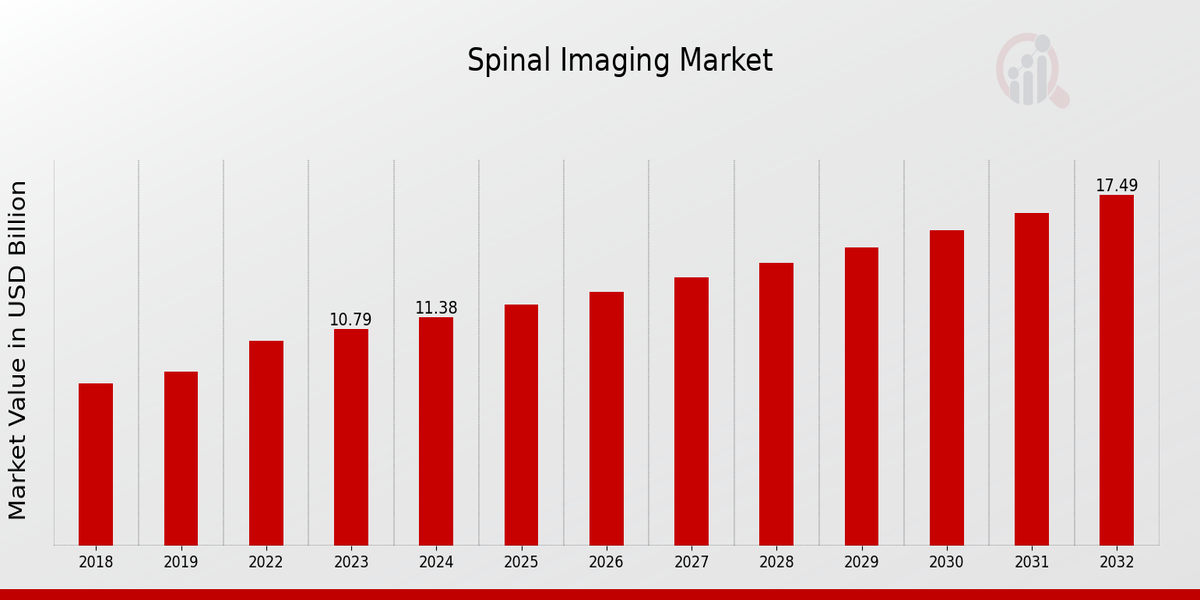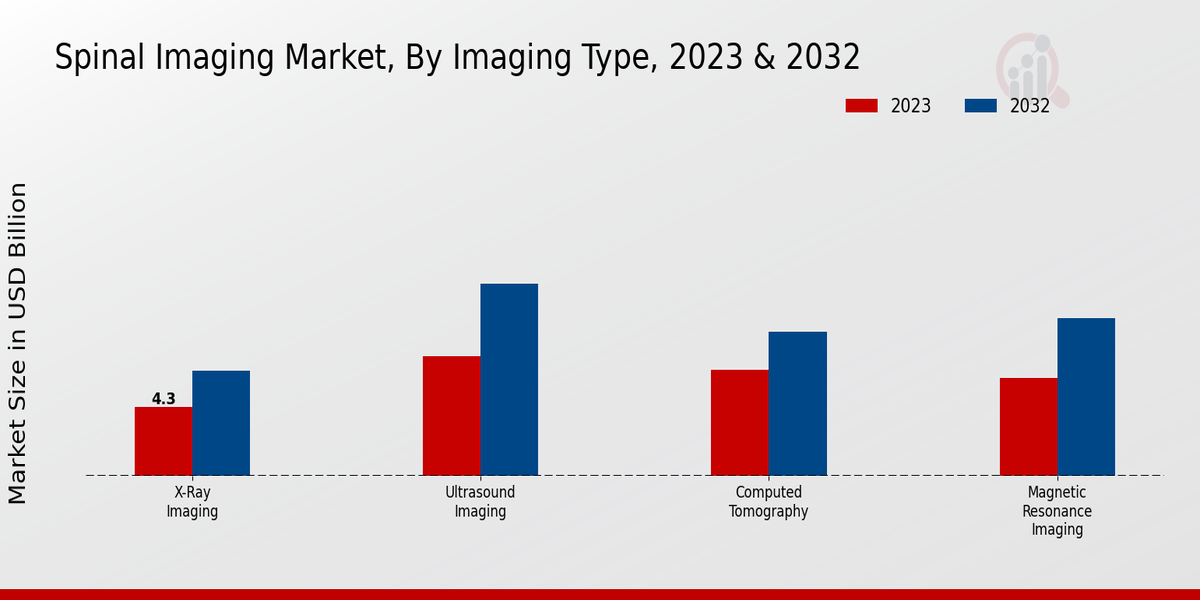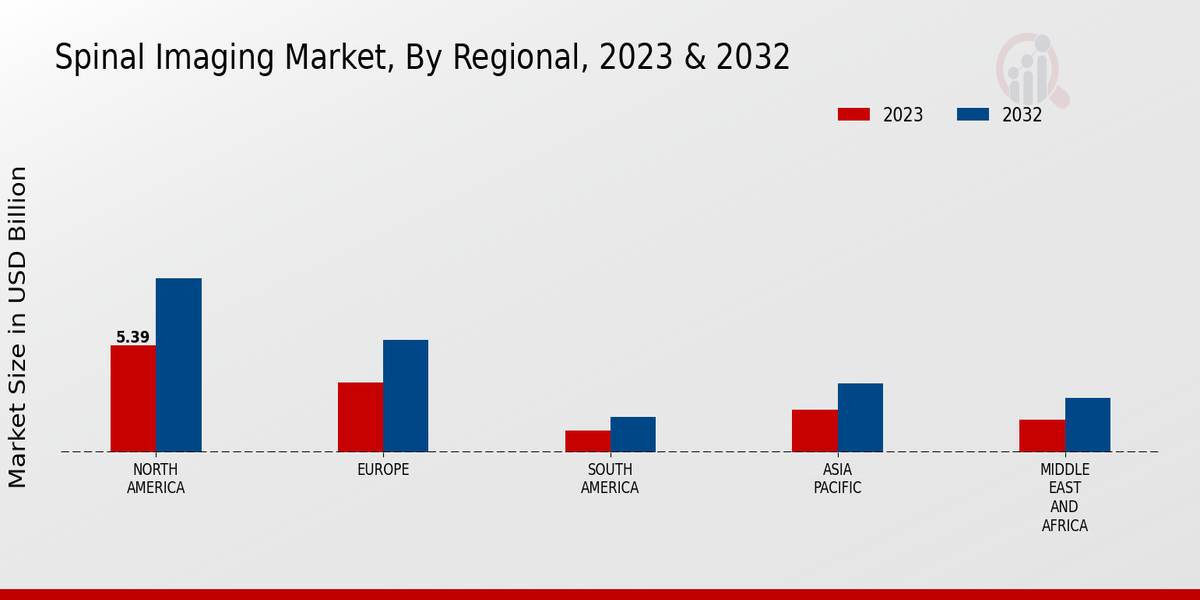Spinal Imaging Market Overview
As per MRFR analysis, the Spinal Imaging Market Size was estimated at 10.22 (USD Billion) in 2022. The Spinal Imaging Market Industry is expected to grow from 10.79(USD Billion) in 2023 to 17.5 (USD Billion) by 2032. The Spinal Imaging Market CAGR (growth rate) is expected to be around 5.52% during the forecast period (2024 - 2032).
Key Spinal Imaging Market Trends Highlighted
Increased technological progression of imaging modalities, the growing burden of spinal disorders, increased rotation towards spinal care, and growing inclination towards adoption of diminished invasive methods are the factors that are shaping the spinal imaging market.
The growing integration of AL and ML technologies also creates a potential for improvements in AI-based image interpretation for spinal imaging. In addition, the creation of portable devices containing sensors for round-the-clock spinal assessment and telemedicine for remote care are other opportunities in the market.
Some of the other trends seen in the spinal imaging market include increasing utilization of hybrid modalities such as PET-CT or SPECT-CT to improve the accuracy of spinal imaging. Further, with the availability of intraoperative imaging systems, like fluoroscopic systems and C-arms, intraoperative guidance during surgical operations is becoming common practice.

Source: Primary Research, Secondary Research, MRFR Database and Analyst Review
Spinal Imaging Market Drivers
Advancements in Imaging Technology
The Spinal Imaging Market is increasing day by day due to the advanced technology used in imaging. Technological advancements make the spine more detailed and precise, while imaging provides accurate diagnosis and treatment plans. High-field MRI systems are introduced with more powerful magnetic fields that give the view of anatomical structures more detail and also improve tissue characterization. Nowadays, artificial intelligence algorithms are used for image representation, which provides accurate results in less time.These technology trends help to grow the market share as there is an increase in patient care outcomes and efficiency in clinical workflow.
Increasing Prevalence of Spinal Disorders
Another major factor boosting the Spinal Imaging Market Industry is the rising prevalence of spinal disorders. With the aging population, a growing emphasis on healthy lifestyles and the increase in obesity, the number of people with back problems has been growing steadily. Degenerative disc disease, spinal stenosis and spinal tumors all require precise imaging to diagnose and monitor. Thus, the demand for better and more timely tests is on the rise.With the increasing awareness of the importance of spinal health and new diagnostic approaches, more patients seek medical help, thus driving the growth of the market.
Growing Demand for Minimally Invasive Procedures
Furthermore, the increasing interest in minimally invasive spinal procedures is driving forward the Spinal Imaging Market Industry. Flouroscopy-guided spine surgeries and percutaneous spinal fusion, for instance, are the two forms of minimally invasive therapies. Moreover, they provide certain advantages over more invasive alternatives, such as limited trauma, faster recovery time, and better results for patients. Additionally, in each of these procedures, spinal imaging is used to guide and visualize the process in real-time, ensuring the process is successfully performed and avoiding complications.Moreover, as minimally invasive operations become more popular with patients, demand for spinal imaging is expected to grow.
Spinal Imaging Market Segment Insights
Spinal Imaging Market Imaging Type Insights
The Spinal Imaging Market segmentation by Imaging Type includes X-ray Imaging, Magnetic Resonance Imaging, Computed Tomography, and Ultrasound Imaging. Among all the imaging types, MRI dominated the market in 2023, which accounted for more than 40% of the Spinal Imaging Market revenue. The growth of this segment may be somewhat limited by the high cost of MRI systems and the need for skilled operators to carry out the scan. However, the fact that an MRI is non-invasive and affords such a detailed image of soft tissues is one of the keys to the dominance of MRI in the market and is one of the factors that will lead to its continued market growth in the future.X-ray is another primary imaging type that is widely used in the spinal imaging market segment. It is less expensive and somewhat more readily available than MRI, which makes it one of the first choices for initial imaging scans and for screening purposes. On the other hand, this type of imaging does not provide much information about soft tissues. CT imaging is another key segment in the market. It is more expansive, however, and provides cross-sectional images of the spine, which is quite useful in diagnosing certain diseases of the spine. In comparison, X-ray is cheaper; however provides images in a single plane only and thus is somewhat less informative.Ultrasound imaging is a non-invasive imaging scan using sound waves, a radiation-free scan that produces images of the spine. It is the least expensive imaging scan that is widely used to evaluate ultrasonographic imaging of the spine for spinal stenosis or a herniated disc. The Spinal Imaging Market is expected to continue to grow in the future due to the increasing demand and technological advancement of imaging equipment. The growth of developing countries, especially China and India, will also be a major factor in the growth of this market.

Source: Primary Research, Secondary Research, MRFR Database and Analyst Review
Spinal Imaging Market Application Insights
There are three major applications in the Spinal Imaging Market, and they are Diagnostic Imaging, Image-Guided Surgery, and Surgical Planning. The greatest contribution to the Spinal Imaging Market is made by the Diagnostic Imaging segment, which will take more than 60% of the market share in 2023. This high contribution of the Diagnostic Imaging segment is explained by the high demand for imaging procedures including X-rays, CT scans, and MRI scans used for the diagnosis of various conditions and diseases of the spine. At the same time, the Image-Guided Surgery segment is expected to grow at the highest rate through the forecast period, taking 6.5% from 2023 to 2032.The growth of this segment is related to the increasing application of different minimally invasive surgical procedures, which require strict image guidance. The growth of the Surgical Planning segment, in turn, is going to be lower and remain moderate over the forecast period. It is explained by the steady demand for the effective preoperative planning of surgical procedures to improve the quality of surgical outcomes.
Spinal Imaging Market Indication Insights
The Spinal Imaging Market is segmented by indication into traumatic spinal cord injuries, degenerative spinal disorders, spinal fractures and dislocations, and spinal tumors. Among these, degenerative spinal disorders held the largest market share of 47.5% in 2023 and is expected to maintain its dominance throughout the forecast period. The increasing prevalence of osteoarthritis, osteoporosis, and other degenerative conditions is driving the growth of this segment. Spinal fractures and dislocations are the second-largest segment, accounting for 26.8% of the market in 2023.The rising incidence of trauma and accidents is contributing to the growth of this segment. Traumatic spinal cord injuries accounted for 18.2% of the market in 2023 and are expected to witness a CAGR of 5.9% during the forecast period. The increasing number of road accidents and sports injuries is fueling the growth of this segment. Spinal tumors accounted for the smallest share of the market in 2023, at 7.5%. However, this segment is expected to register a CAGR of 6.2% during the forecast period, owing to the rising incidence of cancer and the increasing use of advanced imaging techniques for tumor diagnosis and monitoring.
Spinal Imaging Market End User Insights
The Spinal Imaging Market Segmentation by End User comprises Hospitals, Diagnostic Imaging Centers, and Ambulatory Surgical Centers. Hospitals dominated the market in 2023 and are projected to maintain their dominance throughout the forecast period. The increasing prevalence of spinal disorders, coupled with the rising number of spinal surgeries, is driving the growth of the hospital segment. Diagnostic Imaging Centers are expected to witness a significant growth rate during the forecast period due to the increasing demand for outpatient imaging services.Ambulatory Surgical Centers are also expected to grow steadily as they offer a more cost-effective and convenient alternative to hospitals for certain spinal procedures.
Spinal Imaging Market Regional Insights
Regionally, North America held the largest market share in 2023 and is expected to maintain its dominance throughout the forecast period. The growth in this region can be attributed to the presence of a large patient population suffering from spinal disorders, technological advancements, and favorable reimbursement policies. Europe accounted for the second-largest market share in 2023 and is expected to continue its dominance during the forecast period. The growth in this region is driven by factors such as increasing awareness about spinal disorders, growing demand for minimally invasive procedures, and the presence of a well-established healthcare infrastructure.APAC is expected to witness the fastest growth during the forecast period due to factors such as rising healthcare expenditure, increasing prevalence of spinal disorders, and growing demand for advanced imaging techniques. South America and MEA are expected to contribute a significant share to the Spinal Imaging Market by 2032.

Source: Primary Research, Secondary Research, MRFR Database and Analyst Review
Spinal Imaging Market Key Players And Competitive Insights
Hologic, Inc. is a prominent company in the Spinal Imaging Market. It offers a wide range of spinal imaging solutions, including MRI, CT, and X-ray systems. The company is also known for its innovative technologies, such as the Biograph mCT, which provides both PET and CT imaging to offer detailed anatomical and functional information. It has a global presence and a wide distribution network, enabling it to reach a large number of customers. GE Healthcare also belongs to the Major players in the Spinal Imaging Market. The company offers a diverse array of spinal imaging solutions, including MRI, CT, and ultrasound systems. Advanced imaging technologies of GE Healthcare include the Revolution Apex CT scanner, which delivers high-quality images with a reduced dose of radiation. This company also has a global presence and a strong distribution network, allowing it to reach a large number of customers.
Key Companies in the Spinal Imaging Market Include
- Hologic, Inc.
- Ziehm Imaging GmbH
- Yuyue Tech Co.
- GE Healthcare
- Medtronic
- Vueway Technologies
- Canon Medical Systems Corporation
- Stryker
- Toshiba Medical Systems Corporation
- Shimadzu Corporation
- Koninklijke Philips N.V.
- Boston Scientific Corporation
- Siemens Healthineers
- Neusoft Medical Systems Co., Ltd.
Spinal Imaging Market Industry Developments
The Spinal Imaging Market is poised to witness significant growth over the forecast period, driven by factors such as the rising prevalence of spinal disorders, technological advancements, and increasing healthcare expenditure. In 2023, the market was valued at USD 10.79 billion and is projected to reach USD 17.5 billion by 2032, exhibiting a CAGR of 5.52%. Key market trends include the adoption of artificial intelligence (AI) and machine learning (ML) in spinal imaging, the development of minimally invasive surgical techniques, and the growing demand for personalized medicine. Recent news developments include the launch of new AI-powered spinal imaging systems by major players such as Siemens Healthineers and GE Healthcare, and the increasing adoption of robotic-assisted spinal surgeries.
Spinal Imaging Market Segmentation Insights
Spinal Imaging Market Imaging Type Outlook
- X-ray Imaging
- Magnetic Resonance Imaging (MRI)
- Computed Tomography (CT)
- Ultrasound Imaging
Spinal Imaging Market Application Outlook
- Diagnostic Imaging
- Image-Guided Surgery
- Surgical Planning
Spinal Imaging Market Indication Outlook
- Traumatic Spinal Cord Injuries
- Degenerative Spinal Disorders
- Spinal Fractures and Dislocations
- Spinal Tumors
Spinal Imaging Market End User Outlook
- Hospitals
- Diagnostic Imaging Centers
- Ambulatory Surgical Centers
Spinal Imaging Market Regional Outlook
- North America
- Europe
- South America
- Asia-Pacific
- Middle East and Africa
| Report Attribute/Metric |
Details |
| Market Size 2022 |
10.22(USD Billion) |
| Market Size 2023 |
10.79(USD Billion) |
| Market Size 2032 |
17.5(USD Billion) |
| Compound Annual Growth Rate (CAGR) |
5.52% (2024 - 2032) |
| Report Coverage |
Revenue Forecast, Competitive Landscape, Growth Factors, and Trends |
| Base Year |
2023 |
| Market Forecast Period |
2024 - 2032 |
| Historical Data |
2019 - 2022 |
| Market Forecast Units |
USD Billion |
| Key Companies Profiled |
Hologic, Inc., Ziehm Imaging GmbH, Yuyue Tech Co., GE Healthcare, Medtronic, Vueway Technologies, Canon Medical Systems Corporation, Stryker, Toshiba Medical Systems Corporation, Shimadzu Corporation, Koninklijke Philips N.V., Boston Scientific Corporation, Siemens Healthineers, Neusoft Medical Systems Co., Ltd. |
| Segments Covered |
Imaging Type, Application, Indication, End User, Regional |
| Key Market Opportunities |
AIenabled image analysis Advanced visualization techniques Mobile and portable imaging devices Personalized treatment plans Telemedicine |
| Key Market Dynamics |
Increasing prevalence of spinal disorders Technological advancements Growing demand for minimally invasive procedures Focus on improving patient outcomes Reimbursement policies and regulations. |
| Countries Covered |
North America, Europe, APAC, South America, MEA |
Frequently Asked Questions (FAQ) :
The Spinal Imaging Market is projected to register a CAGR of 5.52% from 2024 to 2032.
The rising prevalence of spinal disorders, technological advancements, and increasing demand for minimally invasive procedures are key factors driving the growth of the Spinal Imaging Market.
Major competitors in the Spinal Imaging Market include GE Healthcare, Siemens Healthineers, Philips Healthcare, Canon Medical Systems, and Hitachi Medical Systems.
Major applications of spinal imaging include spinal cord injury, spinal tumors, spinal deformity, spinal stenosis, and spinal infections.
The Spinal Imaging Market is expected to reach a valuation of USD 17.5 billion by 2032.
Challenges faced by the Spinal Imaging Market include the high cost of equipment, regulatory hurdles, and lack of skilled professionals.
Opportunities for growth in the Spinal Imaging Market include technological advancements, increasing demand for minimally invasive procedures, and rising awareness of spinal disorders.

















